prince rupert
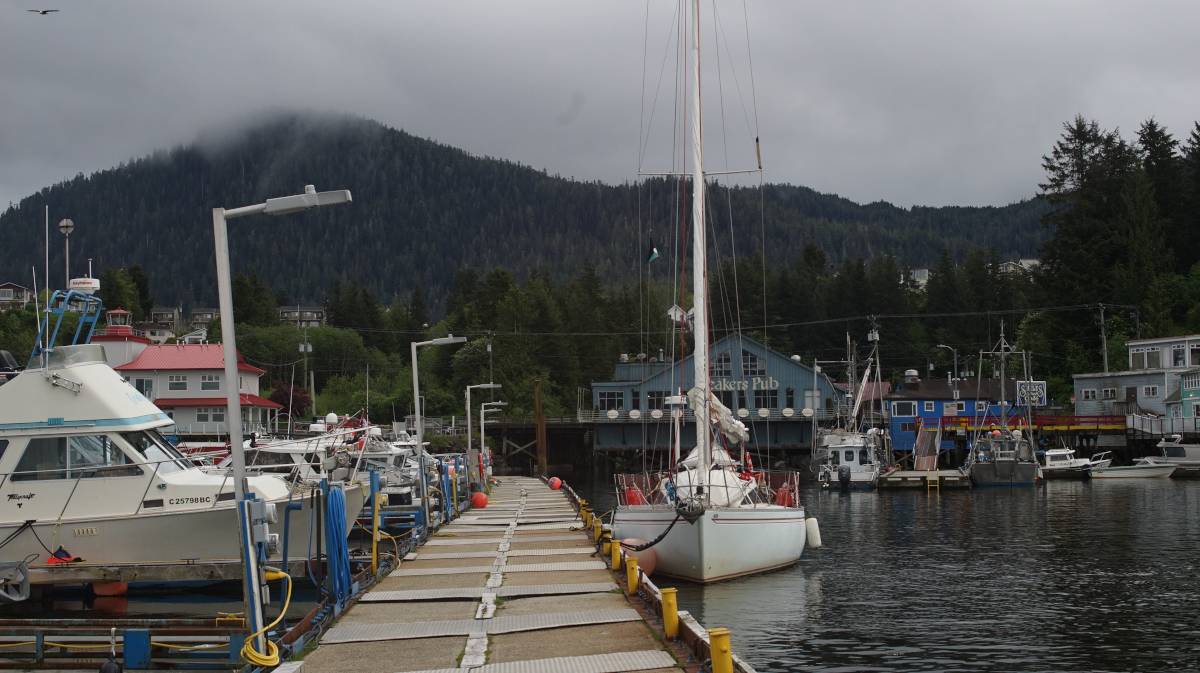
Note. What we refer to on this page as Telegraph Cove, is on the traditional, stolen, unceded, overlapping and/or shared territory land of the Gitxaała and Kitsumkalum Nations; the La̱xyuubm Ts’msyen (Tsimshian) First Nations and the Lax Kw’Alaams band.
On May 29th 2024, Pino arrived in Prince Rupert. This is a milestone for us, we've been reading about this city for a long time, now it has leapt out of the pages of the books and websites we've consulted. We are in it, and thrilled!
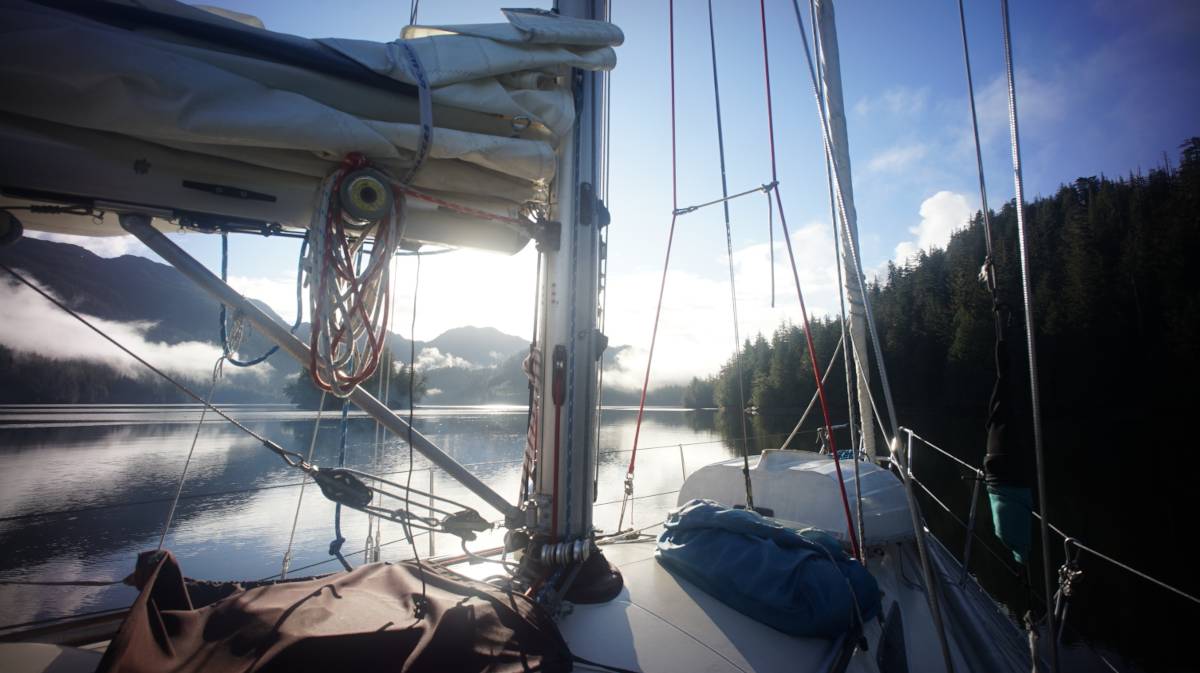
We sailed here from Captain Cove(above photo), an anchorage nestled in the arms of Pitt Island on the northern coast of B.C., at the meeting of Ogden and Petrel Channels. Good winds led us here from Petrel Channel, a lot of it from an incessant barrage of squalls at our stern. They were taking turns at us, filling our sails and allowing us to get there faster than we could have ever imagined. Sailing through Petrel Channel was some of the best sailing we've done, ever. Sailing fast on smooth seas is so pleasant, the boat's movements aren't dampened by waves, and the ride is eerily silent.
The same couldn't be said of our sail from Captain Cove to Prince Rupert... the wind was down, and the current that we assumed would help propel us to our destination was not cooperating, and we couldnt not understand why. We knew that the stream split in half near its northern end, one going north, the other SE, but we were well positioned to ride the northern stream into Arthur Channel. We had coordinated our departure with a rising tide, and we had read in Sailing Directions that in this area the flood went north.
"Ogden Channel: The north-going flood stream sets into Ogden Channel and near its north end it divides, one part turning SE in Grenville Channel, the other continuing north toward Arthur and Telegraph Passages."
Instead of the stream adding to our speed, it ate up 1 precious knot of speed. We couldn't understand it, we continued hugging the north part of the channel. We later learned that this loss in speed may have been due to snowmelt.
"Channel waters contain a significant freshwater component, and the surface water layer of Ogden Channel does not reverse with incoming tides during snowmelt."[Source].
Eventually, some wind came up and helped to restore our loss of speed, then when we turned into Arthur Passage proper, we gained a full knot of speed, and then eventually 1.5 knots. We were speeding at 5.6-6 knots!
We didn't have VHF reception in Captain Cove, so we had no idea what it was like out there. The forecast a few days ago called for 10-20 SW winds, but the weather doesn't need much time to change its mind, it could easily decide to blow harder, but instead, it decided to do the opposite. Once out of Arthur Passage, the waters were smooth, smooth, only disturbed by the passing of a few squalls. We got cell and VHF reception here, we were able to confirm that the wind at Holland Rock was 5-15 knots, nearer to the 5 than to the 15, it seems. With our cell signal restored, we contacted the Prince Rupert Yacht Club to ask if they had any slips available. They weren't there to answer, so I left them an email with our phone number.
Surely enough, Kevin, the harbormaster, gave me a ring, to say that they had room on the dock for us. "What's your speed?" He asked, "4.5 knots." He could track us on AIS, "4.3 here, it says." I laughed, "yea well, been a while since I've checked!" "You'll get an extra knot of speed soon, the flood is ramping up!" Aw, what a nice guy. He insisted that even if we arrived at 1830, which our speed seemed to indicate, that he would be there to show us where to dock, and to catch our lines. "Even at 1830?" I inquired. "Oh yes! We stay around till late, we'll be there!" This was reassuring, we were eager to have a dock to tie to so we could do laundry, and maybe take a shower. If the marina(Cow Bay Marina) and the yacht club were fully booked, we knew we could anchor in Pillsbury Cove or Russell Arm, but if we could have a dock, we'd choose that.
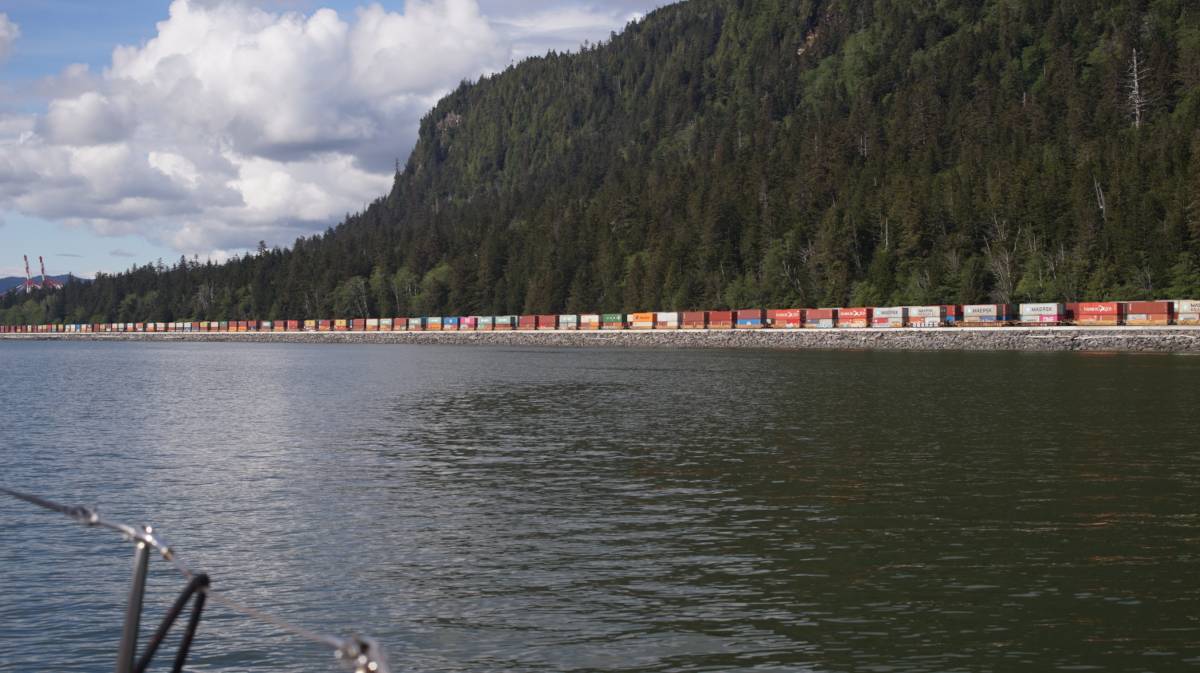
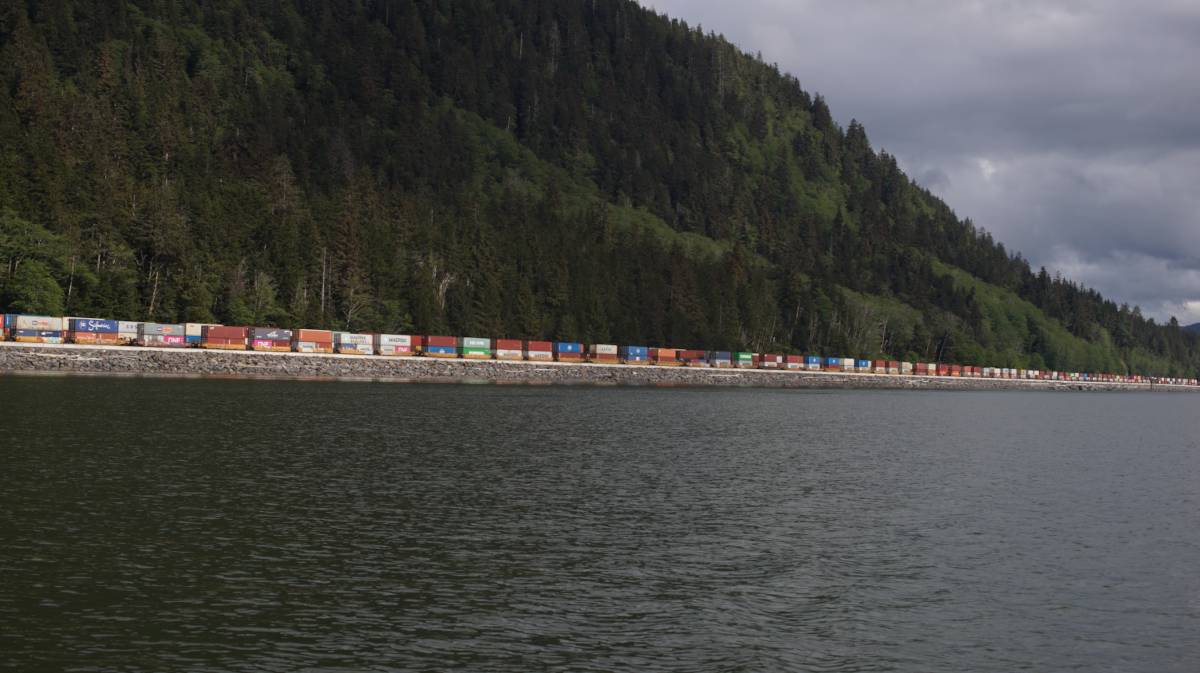
It's a long, long way into the port of Prince Rupert, the channel is very long, and bordered by industry. On our way in, we saw a long line of containers, as far as we could see. The containers were mounted on trains, either to be ferried out, or in, we couldn't tell. The first thing you see when entering is a large container terminal, an impressive sight. They were loading a ship when we passed by.
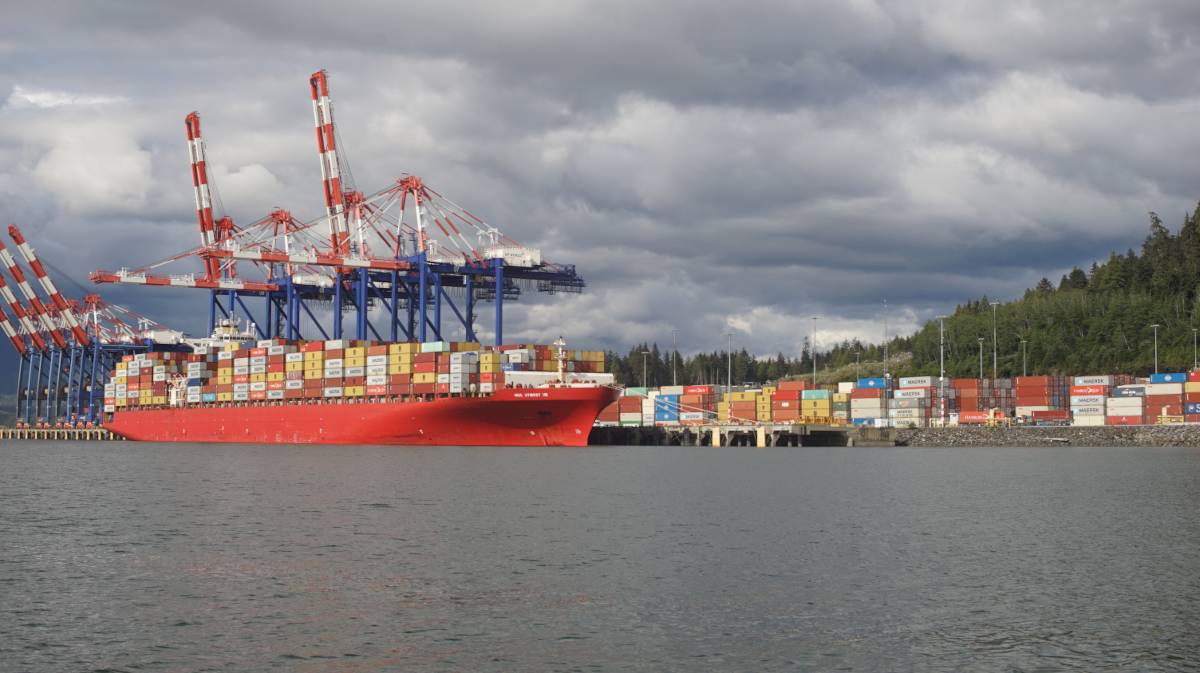
Surely enough, Kevin was around! We saw him on the dock with two young guys, both carrying big drop-style fenders. He pointed to our spot and Devine used the running current to swerve us right into it. The drop fenders were laid between us and the dock, and they caught our lines. Crazy, we thought, we never expect anyone to do this for us, least of all to be here to welcome us at 1830, and to have monitored our arrival on AIS all the while. When docked, he insisted on telling us about the restaurants we ought to try, gave us information about where to find everything, whether its a grocery, showers, laundry, whatever. "We've got the smallest Walmart in the world! You gatta try the beer fries at Breakers Pub! And the coffee here is good and strong." Like in Port McNeill, the people here just love what they do, they're good-natured, happy to help and proud of their city.
Prince Rupert is a very lovely city. After arriving we went out to try and find a plantbased burger and fries, and explored the city on the way. Like all cities by the water, they have old ship props on display, bollards painted like cows (because of the street's proximity to Cow Bay Marina), a store with Memphis-style writing, pubs on stilts... we'd only been in it for 5 minutes and we already loved the place.
Victor and Caroline on Moonshine joined us on our last day in port. We had an evening sharing stories, with a Quebecois friend of theirs, Luc. This would be Moonshine's last port north, this is as far as they wanted to go. They took the following photo of us as we left the harbor on June 1st at 0700.
Our next stop, was Foggy Bay in the US se Alaska. We left to go north through Venn Passage, timing our exit with an outgoing tide, arriving 1 hour before high water(that's when the current turns). Current can flow 2-3 knots here, there are many turns and shoals to avoid, but it's very manageable, and saves a lot of time when arriving and or leaving Prince Rupert.
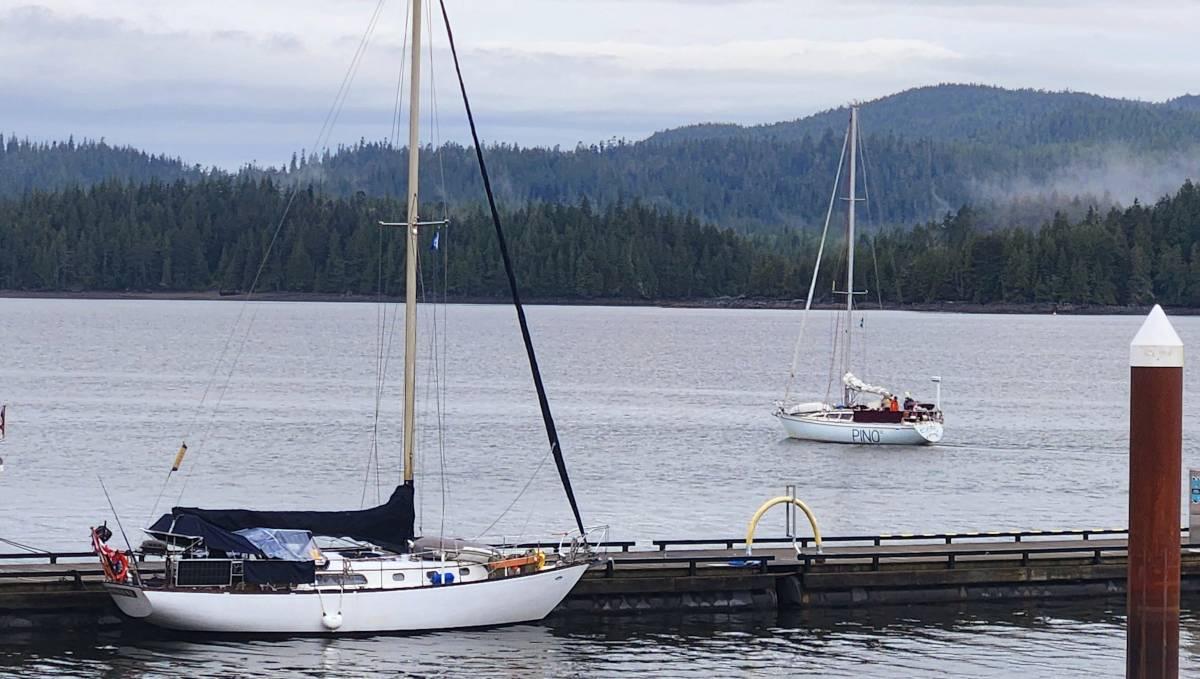
We stopped here again on our way south from July 6th to the 8th. Unfortunately, there aren't other places to check back into Canada. It used to be possible to check in at Haida Gwaii, but like the dock in Ucluelet, they discontinued this option. It's only possible to check into Western Canada in Prince Rupert, Victoria, or Sidney. We used Venn passage again to get into port, even with an adverse current. Peak current that day was 0.60 knots, not strong enough to be bothersome, plus we had 10-20 knots NW wind at our backs to sail with which added to our speed. We didn't expect the wind to stay through the pass, but it did, even weak it helped our progress. On both transits, we were there during high tide, where the current has less pull (depending on the size of the tidal exchange). Venn passage is about 3.8 nautical miles from beginning to end.
Unfortunately, the Prince Rupert Yacht Club fees rise very high in the summer(2.50/foot), but still, we had to dock somewhere to check in. It's a convenient place to do laundry(2$ per load), and not too far from the grocery store. The fuel dock is next door, we walked over with jerry cans to fill our diesel tank, it's a busy dock so doing that works fine, we prefer not to have to move Pino if we don't have to.
In NW winds, the docks get a bit bumpy, the outside of the Cow Bay Marina breakwater is no better. Also, many boats speed through the harbor and can create some pretty nasty wakes. During our time here we put out a bunch of fenders and added snubbers fore and aft to help cushion the motion.
Checking back into Canada. When docked in port, at either Cow Bay Marina or the Yacht Club(apparently those are the only approved marinas for entry into the country), we had to call 1-888-226-7277 to report our arrival. I'm not sure why docking is necessary, but they insisted on it, even if they didn't board us. On the phone they took down our passport information, boat registration, where we'd been, how long, if we had produce(they don't want plants/produce not from a grocery store) ect, then they gave us a clearance number, and that was it.